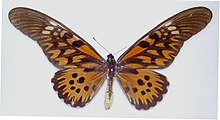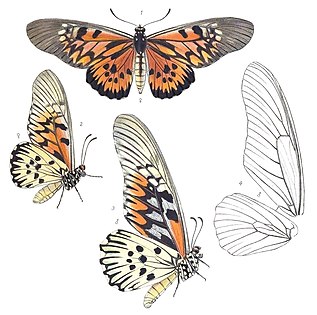| African giant swallowtail | |
|---|---|

| |
| Male, upperside | |
| Scientific classification | |
| Domain: | Eukaryota |
| Kingdom: | Animalia |
| Phylum: | Arthropoda |
| Class: | Insecta |
| Order: | Lepidoptera |
| Family: | Papilionidae |
| Genus: | Papilio |
| Species: | P. antimachus
|
| Binomial name | |
| Papilio antimachus | |
| Synonyms | |
| |
Papilio antimachus, the African giant swallowtail, is a butterfly in the family Papilionidae. With a wingspan between 18 and 23 centimetres (7.1 and 9.1 in), it is the largest butterfly in Africa and among the largest butterflies in the world. The wings are long and narrow and the ground colour is orange brown with black markings. P. antimachus live in the tropical rainforests of west and central Africa. The distribution area (range) stretches from Angola, Cameroon, Democratic Republic of the Congo, Republic of the Congo, Gabon, Ghana, Ivory Coast, Liberia, Nigeria, Sierra Leone, and Uganda. It is much rarer in the west of its range (Guinea to Cameroon) than in the eastern parts of its range. It probably stays in forest canopy but males come down to mud-puddle. The male is larger than the female and can be seen in groups at nectar. The females show themselves less, continually flying high above the treetops. It has been seen hill-topping in Liberia.[3] The butterfly may have no natural enemies because it is very toxic. The larval foodplant is unknown and nothing is published on the early stages (egg, larva, pupa). Cardiac glycosides found in the Imago by Miriam Rothschild [4] indicate that the so-far unidentified larva, most probably, sequesters foodplant toxins which persist through pupation into the imago as an aposematic protection against predation, and therefore that the larval foodplant is probably an asclepiad vine.
Subspecies[edit]
- Papilio antimachus antimachus — Guinea, Sierra Leone, Liberia, Ivory Coast, Ghana, Togo, southern Nigeria, Cameroon, Gabon, Congo, Central African Republic, western Democratic Republic of the Congo, southern Sudan, northern Angola
- Papilio antimachus parva Jackson, 1956 — eastern Democratic Republic of the Congo, Uganda[5][6]
-
Illustrated by Rippon (1894)
- dorsal view of male imago
- lateral view of male imago
- wing venation of female
- magnified head of male
-
Illustrated by Rippon (1894)
- dorsal view of female imago
- lateral view of female imago
- lateral view of male imago
- wing venation of male
References[edit]
- ^ Drury, D. 1782. Illustrations of Natural History 3: xxvi, 1-769 + 2pp. London.
- ^ Papilio, Site of Markku Savela
- ^ Sáfián, Sz. (2013). Observation of hill-topping behaviour by the Giant African Swallowtail - Papilio antimachus Drury, 1782 and other recent records from Liberia (West Africa) (Lepidoptera: Papilionidae). Shilap Revista de Lepidopterología. 41(163):323-329.
- ^ Miriam Rothschild, T Reichstein, J Von Euw, R Aplin, RRM Harman Toxicon 8 (4), 293-296, 1970. Toxic lepidoptera.
- ^ Jackson, 1956 Notes on the Rhopalocera of the Kigezi District of Uganda with descriptions of new species and subspecies J. E Afr. Nat. Hist. Soc. 23 (1) : 63-102, pl. 1-13 Full text
- ^ "Afrotropical Butterflies: File C – Papilionidae - Tribe Papilionini". Archived from the original on 2014-02-22. Retrieved 2012-05-09.
External links[edit]
- Butterflycorner Images from Naturhistorisches Museum Wien
- Tropical and subtropical moist broadleaf forests - WWF Terrestrial Ecoregions


